Cisco ASR 1002-F Router Quick Start Guide
Available Languages
Table of Contents
Site Preparation and Unpacking
Prepare for Equipment Shelf or Tabletop Installation
Prepare for Rack-Mount Installation
Attach the Rack-Mount Brackets—Chassis Front-Mounted
Attach the Rack-Mount Brackets—Chassis Rear-Mounted
Attach the Cable-Management Brackets
Chassis Ground Connection Installation
Console and Auxiliary Port Cable Connections
Management Ethernet Port Cable Connection
Connect the Shared Port Adapter Cables
Install the Cables Using the Cable-Management Bracket
Connect AC Power to the Cisco ASR 1002-F Router
Connect DC Power to the Cisco ASR 1002-F Router
Start the Cisco ASR 1002-F Router
Using the Console to Access the CLI
Configure Global Parameters Using the Set-up Facility
Check the Running Configuration Settings
Save the Running Configuration to NVRAM
Perform Other Configuration Tasks
Powering Off the Cisco ASR 1002-F Router Safely
Replace the Shared Port Adapters
Replace a Power Supply in the Cisco ASR 1002-F Router
Installing the AC Power Supply
Installing the DC Power Supply
Cisco ASR 1002-F Router
Obtaining Documentation and Submitting a Service Request
Cisco ASR 1002-F Router Overview
Documentation and Resources
Documentation for the Cisco ASR 1000 Series Aggregation Services Routers documentation is online with the exception of the regulatory compliance and safety documentation and the Cisco ASR 1000 Series Aggregation Services Routers documentation flyer. For detailed hardware installation instructions, refer to the online Cisco ASR 1000 Series Aggregation Services Routers Hardware Installation Guide. Refer to the following documentation for more information on the Cisco ASR 1000 Aggregation Services Routers:
- Shared port adapter documentation—See the Cisco ASR 1000 Series Aggregation Services Routers SIP and SPA Hardware Installation Guide and Cisco ASR 1000 Series Aggregation Services Routers SIP and SPA Software Configuration Guide
- Configuration documentation—See the Cisco ASR 1000 Series Aggregation Services Routers Software Configuration Guide
Obtaining Documentation and Submitting a Service Request
For information on obtaining documentation, submitting a service request, and gathering additional information, see the monthly What’s New in Cisco Product Documentation, which also lists all new and revised Cisco technical documentation, at:
http://www.cisco.com/en/US/docs/general/whatsnew/whatsnew.html
Subscribe to the What’s New in Cisco Product Documentation as a Really Simple Syndication (RSS) feed and set content to be delivered directly to your desktop using a reader application. The RSS feeds are a free service and Cisco currently supports RSS version 2.0.
Cisco ASR 1002-F Router Overview
The Cisco ASR 1002-F (Fixed) Router is one of the Cisco ASR 1000 Series Aggregation Services Routers. It is the smallest router that supports all the general-purpose routing and security features of the Cisco ASR 1002 Routers. It uses the same internal control and data-plane architecture as the Cisco ASR 1002 Router. For detailed information about the Cisco ASR 1002-F Router, see Cisco ASR 1000 Series Aggregation Services Routers Hardware Installation Guide. Figure 1 shows the front of the Cisco ASR 1002-F Router.
Figure 1 Cisco ASR 1002-F Router — Front View

Prepare for Installation
This section contains information about tools and parts, warnings, site preparation information, and information for equipment shelf or tabletop installation and rack-mount installation.

Warning![]() Only trained and qualified personnel should install, replace, or service this equipment. Statement 1030
Only trained and qualified personnel should install, replace, or service this equipment. Statement 1030


Note![]() Only Cisco software release code four supports the new Cisco ASR 1002-F Router. Do not use earlier versions of Cisco software code.
Only Cisco software release code four supports the new Cisco ASR 1002-F Router. Do not use earlier versions of Cisco software code.
Before beginning this router installation, read the Regulatory Compliance and Safety Information for the Cisco ASR 1000 Series Aggregation Services Router s document.
Site Preparation and Unpacking
- Lift the router safely out of the packing container.
- Ensure the power service at the site is suitable for the router you are installing.
- Check the packing slip to ensure that all the proper components are present.
- Locate and have accessible the Site Log for recording information about this installation.
Tools and Parts
Use the following list of tools and parts as a checklist for preparing to install the Cisco ASR 1002-F Router:
- ESD-preventative wrist strap
- AC power cord
- Appropriate cables to connect the router to the network and to the console terminal
- Tape measure and level (optional)
- Screwdrivers: Number 2 Phillips screwdriver and 3.5-mm or 3/16-inch flat-blade screwdriver
- Chassis ground lugs and screws
- The rack-mount kit includes screws for the 19-inch rack-mount brackets (front and rear rails)
- Two cable management brackets and screws for both sides of the chassis
Prepare for Equipment Shelf or Tabletop Installation
For an equipment shelf or tabletop installation, verify the following before installing the router:
- The router is off the floor and has adequate ventilation.
- An adequate chassis ground (earth) connection exists for the router.
- The router needs at last 3 inches (7.62 cm) of clearance at the inlet and exhaust vents (front and rear of router).
- The router needs 19 inches (48.26 cm) of clearance at the front and rear to allow for installation or to access cables or equipment.
Prepare for Rack-Mount Installation
Before you begin the rack-mounting tasks:
- Decide whether or not you want to front-mount or rear-mount the chassis.
- Decide whether or not you want to attach cable-management brackets to your chassis.

Note![]() If you install cable-management brackets, make certain that you use the specified rack-mount ear holes as stated in the procedure and install the brackets after the chassis is mounted in the equipment rack.
If you install cable-management brackets, make certain that you use the specified rack-mount ear holes as stated in the procedure and install the brackets after the chassis is mounted in the equipment rack.
Rack-Mount the Router
This section provides information for rack-mounting the router.
Attach the Rack-Mount Brackets—Chassis Front-Mounted
To install the rack-mount brackets on a Cisco ASR 1002-F Router for a front rack-mount configuration, follow these steps:
Step 1![]() Locate the threaded holes in the front sides of the chassis.
Locate the threaded holes in the front sides of the chassis.
Step 2![]() Align the rack-mount bracket to the side of the router. Depending on which set of rack-mount bracket holes you choose to use to attach the rack-mount bracket to the router, the chassis will either be recessed in the rack or protrude from the rack.
Align the rack-mount bracket to the side of the router. Depending on which set of rack-mount bracket holes you choose to use to attach the rack-mount bracket to the router, the chassis will either be recessed in the rack or protrude from the rack.
Step 3![]() Position the front rack-mount bracket top hole with the chassis first top hole behind the side vent holes as shown in Figure 2.
Position the front rack-mount bracket top hole with the chassis first top hole behind the side vent holes as shown in Figure 2.
Figure 2 Attaching Front Rack-Mount Brackets for the Cisco ASR 1002-F Router
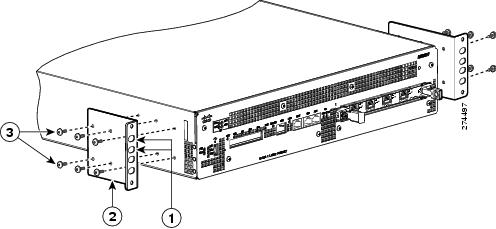
Step 4![]() Insert and tighten the black screws on one side.
Insert and tighten the black screws on one side.
Step 5![]() Repeat Step 1 through Step 4 on the other side of the chassis.
Repeat Step 1 through Step 4 on the other side of the chassis.
Step 6![]() To install the cable-management bracket, see the “Attach the Cable-Management Brackets” section.
To install the cable-management bracket, see the “Attach the Cable-Management Brackets” section.
Attach the Rack-Mount Brackets—Chassis Rear-Mounted
To install the rack-mount bracket on a Cisco ASR 1002-F Router for a rear rack-mount configuration, follow these steps:
Step 1![]() Align the rack-mount bracket to the side of the router and locate the threaded ear holes in the rear sides of the chassis.
Align the rack-mount bracket to the side of the router and locate the threaded ear holes in the rear sides of the chassis.
Step 2![]() Position the rear rack-mount bracket top hole with the chassis from the back (See Figure 3). Make certain that you hold the rear rack-mount bracket with the ear holes facing outward and towards the rear of the chassis.
Position the rear rack-mount bracket top hole with the chassis from the back (See Figure 3). Make certain that you hold the rear rack-mount bracket with the ear holes facing outward and towards the rear of the chassis.
Figure 3 Attaching the Cisco ASR 1002-F Router Rear Rack-Mount Brackets
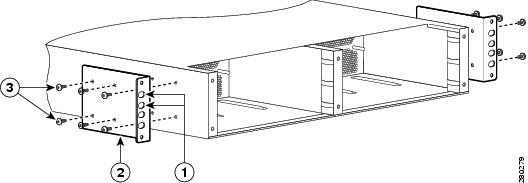
Step 3![]() Insert and tighten the screws.
Insert and tighten the screws.
Step 4![]() Repeat Step 1 through Step 3 on the other side of the chassis.
Repeat Step 1 through Step 3 on the other side of the chassis.
This completes the procedure for attaching rear rack-mount brackets to the chassis. Continue to the section Four-Post Rack Installation or the section Two-Post Rack Installation.
Four-Post Rack Installation
To install the chassis in a four-post rack, read the notes before you begin and then follow the steps listed in this section.

Note![]() Inner clearance (the width between the inner sides of the two posts or rails) must be at least 19 inches (48.26 cm).
Inner clearance (the width between the inner sides of the two posts or rails) must be at least 19 inches (48.26 cm).

Note![]() We recommend that you allow at least 1 or 2 inches (2.54 or 5.08 cm) of vertical clearance between the router and any equipment directly above and below it.
We recommend that you allow at least 1 or 2 inches (2.54 or 5.08 cm) of vertical clearance between the router and any equipment directly above and below it.
Figure 4 shows the Cisco ASR 1002-F Router in a four-post rack.
Figure 4 Installing the Cisco ASR 1002-F Router in a Four-Post Rack - Front and Rear Rack-Mounting
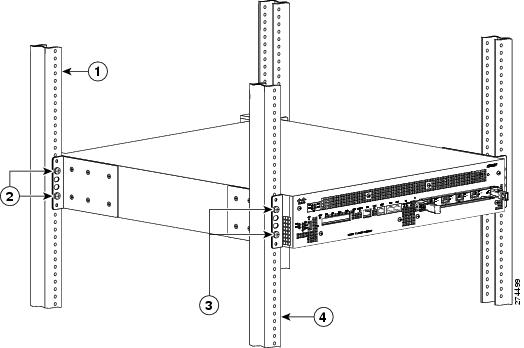

Note![]() Because the rack-mount brackets support the weight of the entire chassis, be sure to use all the screws to fasten the rack-mount brackets on the chassis to the rack posts.
Because the rack-mount brackets support the weight of the entire chassis, be sure to use all the screws to fasten the rack-mount brackets on the chassis to the rack posts.

Note![]() Make certain that you attach the cable-management bracket to the chassis after you install the chassis in an equipment rack.
Make certain that you attach the cable-management bracket to the chassis after you install the chassis in an equipment rack.
To install the chassis in the four-post rack, complete the following steps:
Step 1![]() Make sure that your path to the rack is unobstructed and if the rack is on wheels, ensure that the brakes are engaged or that the rack is otherwise stabilized.
Make sure that your path to the rack is unobstructed and if the rack is on wheels, ensure that the brakes are engaged or that the rack is otherwise stabilized.
Step 2![]() On the chassis, ensure that all screw fasteners on all installed components are securely tightened.
On the chassis, ensure that all screw fasteners on all installed components are securely tightened.
Step 3![]() Lift the chassis into position between the rack posts (requires two people).
Lift the chassis into position between the rack posts (requires two people).
Step 4![]() Position the chassis until the rack-mount bracket ears are flush against the mounting rails on the rack. At this point, if there is a third person, then that person can insert the screws while the other two people hold the chassis in place, unless the chassis is resting on a shelf.
Position the chassis until the rack-mount bracket ears are flush against the mounting rails on the rack. At this point, if there is a third person, then that person can insert the screws while the other two people hold the chassis in place, unless the chassis is resting on a shelf.

Tip![]() Insert the bottom screw first and then the second screw at the top of the chassis diagonally from the bottom screw. This helps secure the chassis in place while you insert the other screws.
Insert the bottom screw first and then the second screw at the top of the chassis diagonally from the bottom screw. This helps secure the chassis in place while you insert the other screws.

Tip![]() To allow space to attach the cable-management brackets to the chassis in the rack easily, make certain that you use the rack-mount bracket ear holes specified in Step 5.
To allow space to attach the cable-management brackets to the chassis in the rack easily, make certain that you use the rack-mount bracket ear holes specified in Step 5.
Step 5![]() Hold the chassis in position against the mounting rails and follow these steps:
Hold the chassis in position against the mounting rails and follow these steps:
a.![]() Insert the bottom screw into the second bracket ear hole from the bottom of the rack-mount bracket ear and use a hand-held screwdriver to tighten the screw to the rack rail.
Insert the bottom screw into the second bracket ear hole from the bottom of the rack-mount bracket ear and use a hand-held screwdriver to tighten the screw to the rack rail.
b.![]() Insert the top screw into the second bracket ear hole from the top of the rack-mount bracket ear hole diagonally from the bottom screw and tighten the screw to the rack rail. See Figure 4.
Insert the top screw into the second bracket ear hole from the top of the rack-mount bracket ear hole diagonally from the bottom screw and tighten the screw to the rack rail. See Figure 4.
c.![]() Repeat Step 4 and Step 5 for the other side of the chassis.
Repeat Step 4 and Step 5 for the other side of the chassis.

Note![]() As a result of using the specified rack-mount bracket ear holes, the cable-management bracket can be attached easily to the rack-mount bracket after the chassis is in the rack.
As a result of using the specified rack-mount bracket ear holes, the cable-management bracket can be attached easily to the rack-mount bracket after the chassis is in the rack.
This completes the procedure for installing the chassis in a four-post rack. Proceed to the “Attach the Cable-Management Brackets” section to continue the installation.
Two-Post Rack Installation
To install the chassis in a two-post rack, read the notes before you begin and then follow the steps listed in this section.

Note![]() Inner clearance (the width between the inner sides of the two posts or rails) must be at least 19 inches (48.26 cm).
Inner clearance (the width between the inner sides of the two posts or rails) must be at least 19 inches (48.26 cm).

Note![]() Make certain that you attach the cable-management brackets to the chassis after you install the chassis in an equipment rack.
Make certain that you attach the cable-management brackets to the chassis after you install the chassis in an equipment rack.
Figure 5 shows the Cisco ASR 1002-F Router installed in a two-post rack
Figure 5 Installing the Cisco ASR 1002-F Router in a Two-Post Rack


Step 1![]() Position the chassis so the front is closest to you and slide the chassis into the rack, pushing it back until the rack-mount brackets meet the mounting strips or posts on both sides of the rack. To prevent injury, avoid any sudden twists or moves.
Position the chassis so the front is closest to you and slide the chassis into the rack, pushing it back until the rack-mount brackets meet the mounting strips or posts on both sides of the rack. To prevent injury, avoid any sudden twists or moves.
Step 2![]() Make certain that the chassis rack-mount bracket ears are flush against the mounting rails on the rack.
Make certain that the chassis rack-mount bracket ears are flush against the mounting rails on the rack.

Note![]() Because the rack-mount brackets support the weight of the entire chassis, be sure to use all screws to fasten the rack-mount brackets on the chassis to the rack posts.
Because the rack-mount brackets support the weight of the entire chassis, be sure to use all screws to fasten the rack-mount brackets on the chassis to the rack posts.

Tip![]() To allow space to attach the cable-management brackets to the chassis in the rack easily, make certain that you use the rack-mount bracket ear holes specified in Step 3.
To allow space to attach the cable-management brackets to the chassis in the rack easily, make certain that you use the rack-mount bracket ear holes specified in Step 3.
Step 3![]() Hold the chassis in position and follow these steps:
Hold the chassis in position and follow these steps:
a.![]() Insert the bottom screw into the fifth hole from the top of the rack-mount bracket ear and use a hand-held screwdriver to tighten the screw to the rack rail.
Insert the bottom screw into the fifth hole from the top of the rack-mount bracket ear and use a hand-held screwdriver to tighten the screw to the rack rail.
b.![]() Insert the top screw into the second bracket ear hole from the top of the rack-mount bracket ear hole diagonally from the bottom screw and tighten the screw to the rack rail. See Figure 5.
Insert the top screw into the second bracket ear hole from the top of the rack-mount bracket ear hole diagonally from the bottom screw and tighten the screw to the rack rail. See Figure 5.
Step 4![]() Repeat Step 2 and Step 3 for the other side of the chassis.
Repeat Step 2 and Step 3 for the other side of the chassis.

Note![]() As a result of using the specified rack-mount bracket ear holes, the cable-management bracket can be attached easily to the rack-mount bracket after the chassis is in the rack.
As a result of using the specified rack-mount bracket ear holes, the cable-management bracket can be attached easily to the rack-mount bracket after the chassis is in the rack.
This completes the procedure for installing the chassis in a two-post rack. Proceed to the “Attach the Cable-Management Brackets” section to continue the installation.
Attach the Cable-Management Brackets
The cable-management brackets for the Cisco ASR 1002-F Router contain one independent cable-management “U” feature with two screws for each bracket. For the Cisco ASR 1000 Series SIP, these brackets work in tandem with SPA cable-management brackets to allow installation and removal of adjacent SPAs without the need to remove cables.

Note![]() Make certain that the cable-management bracket “U” feature (open end) is facing upwards when you attach it to the chassis.
Make certain that the cable-management bracket “U” feature (open end) is facing upwards when you attach it to the chassis.
Follow these steps to attach the cable-management brackets to both sides of the Cisco ASR 1002-F Router in the rack:
Step 1![]() Align the cable-management bracket to the rack-mount bracket on one side of the Cisco ASR 1002-F Router. The cable-management bracket aligns to the top hole of the chassis rack-mount bracket.
Align the cable-management bracket to the rack-mount bracket on one side of the Cisco ASR 1002-F Router. The cable-management bracket aligns to the top hole of the chassis rack-mount bracket.

Note![]() Use the package of four screws that came with the cable-management bracket package.
Use the package of four screws that came with the cable-management bracket package.
Step 2![]() Insert one screw through the top screw hole of the cable-management bracket and into the chassis rack-mount bracket and tighten the screw using a Phillips screwdriver.
Insert one screw through the top screw hole of the cable-management bracket and into the chassis rack-mount bracket and tighten the screw using a Phillips screwdriver.
Figure 6 Attaching the Cable-Management Brackets to the Cisco ASR 1002-F Router
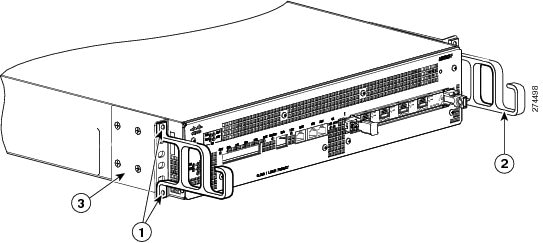
Step 3![]() Insert one screw through the bottom screw hole of the cable-management bracket and into the chassis rack-mount bracket and tighten the screw using a Phillips head screwdriver. Figure 6 shows the cable-management brackets attached to the chassis.
Insert one screw through the bottom screw hole of the cable-management bracket and into the chassis rack-mount bracket and tighten the screw using a Phillips head screwdriver. Figure 6 shows the cable-management brackets attached to the chassis.
Step 4![]() Repeat Step 1 through Step 3 for the other side of the Cisco ASR 1002-F Router.
Repeat Step 1 through Step 3 for the other side of the Cisco ASR 1002-F Router.
This completes the procedure for installing the cable-management brackets on a Cisco ASR 1002-F Router for a chassis rack-mount configuration.
Chassis Ground Connection Installation
Before you connect power or turn on power to your router, you must provide an adequate chassis ground (earth) connection for the Cisco ASR 1002-F Router. The two-hole chassis ground lug and the respective screws that ship with your Cisco ASR 1002-F Router.
The following tools, equipment, and supplies are necessary to connect the system ground to the chassis:
- Phillips screwdriver
- Dual-lug chassis ground component (two) and respective screws (four) (shipped with the accessory kit)
- Grounding wire
See Figure 7 for the location of the chassis ground connector on the Cisco ASR 1002-F Router.
Figure 7 Cisco ASR 1002-F Router Ground Connector Location and eUSB Panel Door

Step 1![]() Use the wire stripper to strip one end of the AWG #6 wire approximately 0.75 inches (19.05 mm).
Use the wire stripper to strip one end of the AWG #6 wire approximately 0.75 inches (19.05 mm).
Step 2![]() Insert the AWG #6 wire into the wire receptacle on the ground lug.
Insert the AWG #6 wire into the wire receptacle on the ground lug.
Step 3![]() Use a manufacturer’s recommended crimping tool to carefully crimp the wire receptacle around the wire; this step is required to ensure a proper mechanical connection.
Use a manufacturer’s recommended crimping tool to carefully crimp the wire receptacle around the wire; this step is required to ensure a proper mechanical connection.
Figure 8 Attaching a Ground Lug to the Chassis Ground Connector
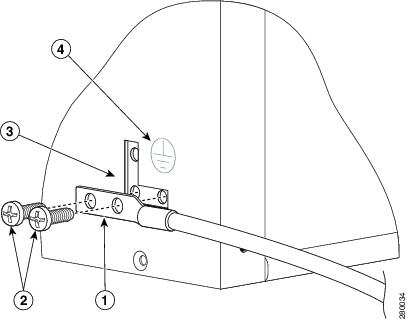
Step 4![]() Locate the chassis ground connector on the side of your chassis.
Locate the chassis ground connector on the side of your chassis.
Step 5![]() Insert the two screws through the holes in the ground lug.
Insert the two screws through the holes in the ground lug.
Step 6![]() Use the Number 2 Phillips screwdriver to carefully tighten the screws until the ground lug is held firmly to the chassis. Do not overtighten the screws.
Use the Number 2 Phillips screwdriver to carefully tighten the screws until the ground lug is held firmly to the chassis. Do not overtighten the screws.
Step 7![]() Connect the opposite end of the ground wire to the appropriate ground point at your site to ensure an adequate chassis ground.
Connect the opposite end of the ground wire to the appropriate ground point at your site to ensure an adequate chassis ground.
This completes the procedure for attaching a chassis ground connection. Go to the “Connect the Router to the Network” section for information on attaching cables.
Connect the Router to the Network
This section provides information about cables and ports and attaching the router to the network.
- Console and Auxiliary Port Cable Connections
- Management Ethernet Port Cable Connection
- Connect the Shared Port Adapter Cables
- Install the Cables Using the Cable-Management Bracket
Console and Auxiliary Port Cable Connections
The Cisco ASR 1001 Router has two RJ-45 ports for terminal connection. A console port, which can be utilized for terminal connections and an auxiliary port for additional terminal connections as well as diagnostic utilization.

Step 1![]() Before connecting a terminal to the console port, configure the terminal to match the router console port as follows: 9600 baud, 8 data bits, no parity, 1 stop bits. See Figure 9 for console and auxiliary port connector location.
Before connecting a terminal to the console port, configure the terminal to match the router console port as follows: 9600 baud, 8 data bits, no parity, 1 stop bits. See Figure 9 for console and auxiliary port connector location.
Step 2![]() Connect to the port using the RJ-45-to-DB-9 cable.
Connect to the port using the RJ-45-to-DB-9 cable.
Figure 9 Cisco ASR 1002-F Integrated Route Processor Console and Auxiliary Port Connectors
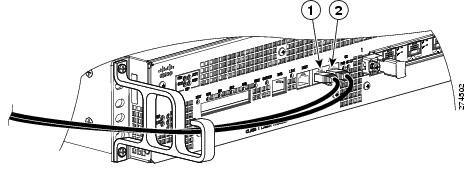
Step 3![]() After you establish normal router operation, you can disconnect the console terminal.
After you establish normal router operation, you can disconnect the console terminal.

Note![]() For console and auxiliary port pinouts, see the Cisco ASR 1002-F Router specifications in Cisco ASR 1000 Series Aggregation Services Routers Hardware Installation Guide.
For console and auxiliary port pinouts, see the Cisco ASR 1002-F Router specifications in Cisco ASR 1000 Series Aggregation Services Routers Hardware Installation Guide.
Management Ethernet Port Cable Connection

To use the Management Ethernet interface on the router, perform the following steps:
Step 1![]() Insert an Ethernet RJ-45 cable into the MGMT ETHERNET port (see Figure 10).
Insert an Ethernet RJ-45 cable into the MGMT ETHERNET port (see Figure 10).
Figure 10 Cisco ASR 1002-F Integrated Route Processor Management Ethernet Port Connector
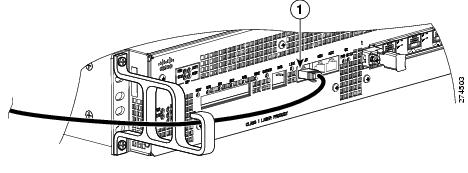
Step 2![]() Insert the other end of the RJ-45 cable to your management device or network.
Insert the other end of the RJ-45 cable to your management device or network.
Step 3![]() Configure the port connection to a fixed speed through the command-line interface (CLI) commands.
Configure the port connection to a fixed speed through the command-line interface (CLI) commands.
Connect the Shared Port Adapter Cables
The instructions for connecting the cables for the shared port adapters installed in the Cisco ASR 1002-F Router are contained in the Cisco ASR 1000 Series Aggregation Services Routers SPA and SIP Hardware Installation Guide.
Install the Cables Using the Cable-Management Bracket
Cables coming off the front side of the Cisco ASR 1002-F integrated RP and SPAs utilize the chassis-level cable-management brackets provided on the chassis rack-mount brackets (see Figure 11).
To secure SPA cables and input or output cables connected to the Cisco ASR 1002-F Router, follow these steps:
Step 1![]() When installing the network interface cables, route the cables up to and through the cable-management bracket ‘U’ device. If you are using very thin cables that slip through the bracket openings, insert nylon cable ties through the holes in the bracket and wrap them around the cables to secure them as shown in Figure 11.
When installing the network interface cables, route the cables up to and through the cable-management bracket ‘U’ device. If you are using very thin cables that slip through the bracket openings, insert nylon cable ties through the holes in the bracket and wrap them around the cables to secure them as shown in Figure 11.
Figure 11 Cisco ASR 1002-F Integrated Route Processor Cable Management
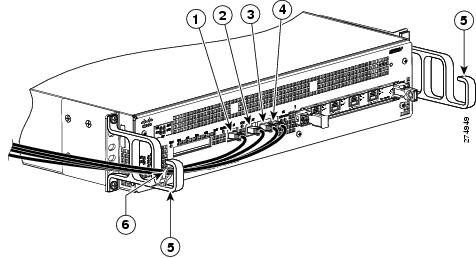
Step 2![]() Route the excess cable out through either end of the bracket, coil it, and secure it to the rack using nylon cable ties or some other mode of attachment.
Route the excess cable out through either end of the bracket, coil it, and secure it to the rack using nylon cable ties or some other mode of attachment.
Step 3![]() It might be necessary to bundle longer cables to avoid tangling them. Do this at the cable-management bracket or at the rack, but leave enough slack in the cables to remove a Cisco ASR 1002-ESP-F and change cables as required. Also, do not block the power supply air vents with cables.
It might be necessary to bundle longer cables to avoid tangling them. Do this at the cable-management bracket or at the rack, but leave enough slack in the cables to remove a Cisco ASR 1002-ESP-F and change cables as required. Also, do not block the power supply air vents with cables.
Figure 12 Bundling Cisco ASR 1002-F Integrated Route Processor Cables

This completes the procedure for installing the cables in the cable-management bracket.
Proceed to the “Start the System” section to complete the installation.
Start the System
Before you start the system, you must connect power to it.
Connect AC Power to the Cisco ASR 1002-F Router
This section provides instructions for installing the AC power supply into the Cisco ASR 1002-F Router. Read the safety warnings before you begin.

Warning![]() Never install an AC power module and a DC power module in the same chassis. Statement 1050
Never install an AC power module and a DC power module in the same chassis. Statement 1050

Warning![]() Installation of the equipment must comply with local and national electrical codes. Statement 1074
Installation of the equipment must comply with local and national electrical codes. Statement 1074

Warning![]() When installing or replacing the unit, the ground connection must always be made first and disconnected last. Statement 1046
When installing or replacing the unit, the ground connection must always be made first and disconnected last. Statement 1046

Warning![]() This equipment must be grounded. Never defeat the ground conductor or operate the equipment in the absence of a suitably installed ground conductor. Contact the appropriate electrical inspection authority or an electrician if you are uncertain that suitable grounding is available. Statement 1024
This equipment must be grounded. Never defeat the ground conductor or operate the equipment in the absence of a suitably installed ground conductor. Contact the appropriate electrical inspection authority or an electrician if you are uncertain that suitable grounding is available. Statement 1024

Warning![]() This unit has power supply connections. All connections must be removed to de-energize the unit. Statement 1028
This unit has power supply connections. All connections must be removed to de-energize the unit. Statement 1028

Warning![]() This product relies on the building’s installation for short-circuit (overcurrent) protection. Ensure that the protective device is rated not greater than: AC power supplies 20 A and DC power supplies 30 A for Cisco ASR 1002-F Routers. Statement 1005
This product relies on the building’s installation for short-circuit (overcurrent) protection. Ensure that the protective device is rated not greater than: AC power supplies 20 A and DC power supplies 30 A for Cisco ASR 1002-F Routers. Statement 1005
Figure 13 shows the AC power supply for the Cisco ASR 1002-F Router.
Figure 13 AC Power Supply for the Cisco ASR 1002-F Router
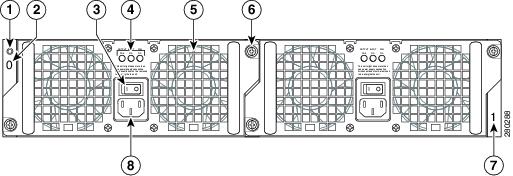
Table 1 describes the AC power supply LEDs on the Cisco ASR 1002-F Router.
Table 1 Cisco ASR 1002-F Router AC Power Supply LEDs

Note![]() To connect an AC power supply to the Cisco ASR 1002-F Router, follow the steps in the Installing the AC Power Supply.
To connect an AC power supply to the Cisco ASR 1002-F Router, follow the steps in the Installing the AC Power Supply.
Connect DC Power to the Cisco ASR 1002-F Router
The DC power supply input connector is a euro-style terminal block. A tab on the back of the power supply provides strain relief to the input wires on the power supply. The connection order is negative (–), positive (+), and ground (GND).
Figure 14 shows the DC power supply for the Cisco ASR 1002-F Router.
Figure 14 DC Power Supply for the Cisco ASR 1002-F Router
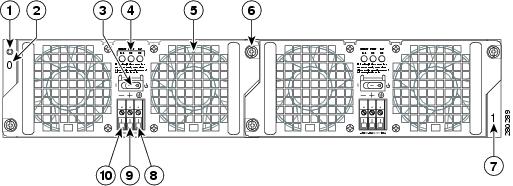
Table 2 describes the DC power supply LEDs on the Cisco ASR 1002-F Router.
Table 2 Cisco ASR 1002-F Router DC Power Supply LEDs
To connect the DC power supply to a Cisco ASR 1002-F Router, follow these steps:
Step 1![]() At the rear of the router, check that the power switch is in the Standby position on the power supply.
At the rear of the router, check that the power switch is in the Standby position on the power supply.

Note![]() The color coding of the DC-input power supply leads depends on the color coding of the DC power source at your site. Typically, green or green/yellow is used for ground. Make certain the lead color coding you choose for the DC-input power supply matches the lead color coding used at the DC power source.
The color coding of the DC-input power supply leads depends on the color coding of the DC power source at your site. Typically, green or green/yellow is used for ground. Make certain the lead color coding you choose for the DC-input power supply matches the lead color coding used at the DC power source.

Warning![]() When installing or replacing the unit, the ground connection must always be made first and disconnected last. Statement 1046
When installing or replacing the unit, the ground connection must always be made first and disconnected last. Statement 1046
Figure 15 Cisco ASR 1002-F Router DC Power Supply

Step 2![]() Ensure that the negative and positive leads are disconnected from the site power source.
Ensure that the negative and positive leads are disconnected from the site power source.
Step 3![]() Using a wire stripper, strip approximately 0.55 inch (14 mm) from the positive, negative, and ground leads.
Using a wire stripper, strip approximately 0.55 inch (14 mm) from the positive, negative, and ground leads.
Step 4![]() Insert the stripped end of the ground lead all the way into the ground lead receptacle on the DC-input power supply, and tighten the receptacle screw using a 3.5 mm flat-blade screwdriver.
Insert the stripped end of the ground lead all the way into the ground lead receptacle on the DC-input power supply, and tighten the receptacle screw using a 3.5 mm flat-blade screwdriver.
Step 5![]() Insert the stripped end of the positive lead all the way into the positive lead receptacle and tighten the receptacle screw using the same 3.5 mm flat-blade screwdriver. Repeat this step for the negative lead.
Insert the stripped end of the positive lead all the way into the positive lead receptacle and tighten the receptacle screw using the same 3.5 mm flat-blade screwdriver. Repeat this step for the negative lead.

Note![]() Make sure the entire stripped end of each lead is inserted all the way into its receptacle. If any exposed wire at the stripped end of a lead is visible after inserting the lead into its receptacle, remove the lead from the receptacle, use the wire stripper to cut the stripped end of the lead, and repeat Step 3 through Step 5.
Make sure the entire stripped end of each lead is inserted all the way into its receptacle. If any exposed wire at the stripped end of a lead is visible after inserting the lead into its receptacle, remove the lead from the receptacle, use the wire stripper to cut the stripped end of the lead, and repeat Step 3 through Step 5.
Step 6![]() After tightening the receptacle screw for the ground, positive, and negative DC-input leads, use a cable tie to secure the three leads to the power supply faceplate.
After tightening the receptacle screw for the ground, positive, and negative DC-input leads, use a cable tie to secure the three leads to the power supply faceplate.

Step 7![]() Connect the ground, positive, and negative leads to the power source.
Connect the ground, positive, and negative leads to the power source.
Step 8![]() Turn on the branch source breaker.
Turn on the branch source breaker.
Step 9![]() Place the Standby switch in the On (|) position.
Place the Standby switch in the On (|) position.
Verify Power Supply Operation
Follow this procedure to verify the power supplies are operating correctly.
Step 1![]() Check that the power supply LEDs are illuminated as follows:
Check that the power supply LEDs are illuminated as follows:
–![]() OUTPUT FAILED LED is not illuminated.
OUTPUT FAILED LED is not illuminated.
Step 2![]() To ensure that the power supply is running, enter the show platform command. This output sample is from a Cisco ASR 1002-F Router.
To ensure that the power supply is running, enter the show platform command. This output sample is from a Cisco ASR 1002-F Router.

Note![]() If the LEDs indicate a power problem or the power supply state shows “ps,fail”, then contact a customer service representative for assistance or additional instructions.
If the LEDs indicate a power problem or the power supply state shows “ps,fail”, then contact a customer service representative for assistance or additional instructions.
Start the Cisco ASR 1002-F Router
Check the following conditions before you start the Cisco ASR 1002-F Router:
- The Cisco ASR 1002-F Router has one slot for the Cisco ASR1002-SIP10-F. Make certain that the SPA is firmly seated in its subslot and its captive installation screws are securely tightened.

Note![]() The ASR 1002-F Router has only one half-height removable SPA.
The ASR 1002-F Router has only one half-height removable SPA.
- The integrated Cisco ASR1002-ESP-F forwarding processor in the Cisco ASR 1002-F Router is secured and its captive screws are securely tightened.
- All network interface cables are connected.
- The console terminal is turned on.
Follow these steps to start the Cisco ASR1002-F Router:
Step 1![]() Turn on power. The green INPUT OK LED on the power supply turns on. (Both power supplies are required in the Cisco ASR 1002-F Router.)
Turn on power. The green INPUT OK LED on the power supply turns on. (Both power supplies are required in the Cisco ASR 1002-F Router.)
Step 2![]() Listen for the fans; you should immediately hear them operating.
Listen for the fans; you should immediately hear them operating.
Step 3![]() During the boot process, observe the system LEDs. The PWR LED should be green. The STAT LED lights yellow to indicate booting and then green when Cisco IOS is running.
During the boot process, observe the system LEDs. The PWR LED should be green. The STAT LED lights yellow to indicate booting and then green when Cisco IOS is running.
Figure 16 Integrated Cisco ASR1002-RP1 and Cisco ASR1002-ESP-F LEDs on Cisco ASR 1002-F Router
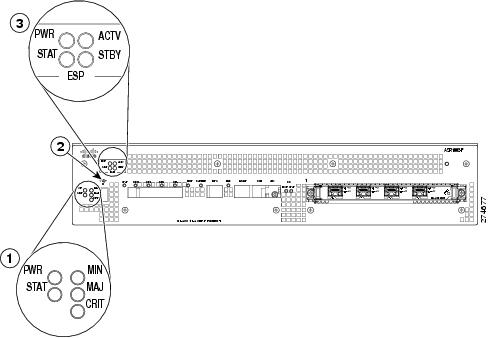
Table 3 provides information about the LEDs on the Cisco ASR 1002-F Router faceplate.
Table 3 Cisco ASR 1002-F Router LED Activity
| **For more information about the small form-factor pluggable (SFP) transceiver modules that are compatible with Cisco ASR 1002 Built-in Gigabit Ethernet Ports (4x1GE), refer to the Modular Optics Compatibility section in the Cisco ASR 1000 Series Aggregation Services Routers SIP and SPA Hardware Installation Guide. |
|||
Table 4 provides information about the Cisco ASR1002-ESP-F LEDs in the Cisco ASR 1002-F Router as the system starts.
Table 4 Cisco ASR1002-ESP-F LED Activity
During the boot process, observe the system LEDs. The STATUS LED comes on immediately as amber, then turns to green when the Cisco IOS is booted.

Note![]() The system boots differently depending on the configuration that ships with your system. The display below is a snapshot of messages that are output on the console of the Cisco ASR 1002-F Router system after power-up and during IOS booting. This is only an example of what you might see from any Cisco ASR 1000 Series Router.
The system boots differently depending on the configuration that ships with your system. The display below is a snapshot of messages that are output on the console of the Cisco ASR 1002-F Router system after power-up and during IOS booting. This is only an example of what you might see from any Cisco ASR 1000 Series Router.
Step 4![]() Observe the initialization process. When the system boot is complete (a few seconds), the Cisco ASR 1002-F integrated route processor begins to initialize. The console screen displays a script and system banner.
Observe the initialization process. When the system boot is complete (a few seconds), the Cisco ASR 1002-F integrated route processor begins to initialize. The console screen displays a script and system banner.
ASR 1002-F-16-rp0-rommon 2 >boot bootflash:asr1000rp1-advipservicesk9.v122_33_xn_asr_rls0_throttle_20080114_045627.bin
#######################################################################################################################
#######################################################################################################################
#####################################################################################################################
Cisco IOS Software, IOS-XE Software (PPC_LINUX_IOSD-ADVENTERPRISEK9-M), Version 12.2(33)XNA, RELEASE SOFTWARE
Compiled Thu 01-May-08 00:29 by mcpre*Feb 13 13:01:36.253: %DYNCMD-7-CMDSET_LOADED: The Dynamic Command set has been loaded from the Shell Manager

Note![]() You have the option of proceeding with the setup command facility to configure the interfaces or exiting from setup and using configuration commands to configure global (system-wide) and interface-specific parameters. You do not have to configure the interfaces immediately; however, you cannot enable the interfaces or connect them to any networks until you have configured them. For detailed software configuration information, see the Cisco ASR 1000 Series Aggregation Services Routers Software Configuration Guide.
You have the option of proceeding with the setup command facility to configure the interfaces or exiting from setup and using configuration commands to configure global (system-wide) and interface-specific parameters. You do not have to configure the interfaces immediately; however, you cannot enable the interfaces or connect them to any networks until you have configured them. For detailed software configuration information, see the Cisco ASR 1000 Series Aggregation Services Routers Software Configuration Guide.
Configure the Router
Use this section for information on configuring the Cisco ASR 1002-F Router.
Using the Console to Access the CLI
To access the command-line interface using the console, follow these steps:
Your system is booting and if you answer No, at the prompt:
Step 1![]() Press
Press Return to enter user EXEC mode. The following prompt appears:
Step 2![]() From user EXEC configuration mode, enter the enable command as shown in the following example:
From user EXEC configuration mode, enter the enable command as shown in the following example:
Step 3![]() At the password prompt, enter your system password. If an enable password has not been set on your system, this step may be skipped. The following example shows entry of the password called enablepass :
At the password prompt, enter your system password. If an enable password has not been set on your system, this step may be skipped. The following example shows entry of the password called enablepass :
Step 4![]() When your enable password is accepted, the privileged EXEC configuration mode prompt appears:
When your enable password is accepted, the privileged EXEC configuration mode prompt appears:
Step 5![]() You now have access to the CLI in privileged EXEC mode and you can enter the necessary commands to complete your desired tasks.
You now have access to the CLI in privileged EXEC mode and you can enter the necessary commands to complete your desired tasks.
Step 6![]() To exit the console session, enter the quit command as shown in the following example:
To exit the console session, enter the quit command as shown in the following example:
Configure Global Parameters Using the Set-up Facility
When you first start the setup program, you must configure the global parameters. These parameters are used for controlling system-wide settings. Complete the following steps to enter global parameters:
Step 1![]() Connect a console terminal to the console port. This is only an example of the output display; prompts may vary. When you see this information, you have successfully booted your router:
Connect a console terminal to the console port. This is only an example of the output display; prompts may vary. When you see this information, you have successfully booted your router:
Step 2![]() The first sections of the configuration script appear only at an initial system startup. On subsequent uses of the setup facility, the script begins with a System Configuration Dialog as shown in the following example:
The first sections of the configuration script appear only at an initial system startup. On subsequent uses of the setup facility, the script begins with a System Configuration Dialog as shown in the following example:
Step 3![]() When asked if you would like to enter the initial configuration dialog, enter yes.
When asked if you would like to enter the initial configuration dialog, enter yes.

Note![]() Basic management setup configures enough connectivity for managing the system; extended setup will ask you to configure each interface on the system. For detailed information about setting global parameters, refer to the Cisco ASR 1000 Series Aggregation Services Routers Software Configuration Guide.
Basic management setup configures enough connectivity for managing the system; extended setup will ask you to configure each interface on the system. For detailed information about setting global parameters, refer to the Cisco ASR 1000 Series Aggregation Services Routers Software Configuration Guide.
Check the Running Configuration Settings
To check the value of the settings you have entered, enter the show running-config command at the Router# prompt:
To review changes you make to the configuration, use the EXEC mode show startup-config command to see the changes and copy run-start command stored in NVRAM.
Save the Running Configuration to NVRAM
To store the configuration or changes to your startup configuration in NVRAM, use the copy running-config startup-config command to save your configuration changes to the startup configuration so that the changes will not be lost if the software reloads or a power outage occurs. For example:
It might take a minute or two to save the configuration. After the configuration has been saved, the following output appears:
This task saves the configuration to NVRAM.
To review changes you make to the configuration, use the EXEC mode show startup-config command to see the changes and copy run-start command stored in NVRAM.

Note![]() Using the copy run-start command saves the configuration settings that you created in the router using configuration mode and the setup facility. If you fail to do this, your configuration will be lost the next time you reload the router.
Using the copy run-start command saves the configuration settings that you created in the router using configuration mode and the setup facility. If you fail to do this, your configuration will be lost the next time you reload the router.
Perform Other Configuration Tasks
To make advanced configuration changes after you establish the basic startup configuration for your router, refer to the Cisco ASR 1000 Series Aggregation Services Routers Software Configuration Guide and modular configuration and modular command reference publications in the Cisco IOS software configuration documentation set that corresponds to the software release installed on your Cisco hardware. These publications contain additional information on using the configure command. The configuration publications also provide information about the following tasks:
After Installation
This section contains hardware replacement instructions for the Cisco ASR 1002-F Router SPAs and power supplies and how to safely power off the router.

Note![]() Unless otherwise noted, the Cisco ASR 1002-F Router power supplies removal and installation remain the same as the existing Cisco ASR 1002 Router.
Unless otherwise noted, the Cisco ASR 1002-F Router power supplies removal and installation remain the same as the existing Cisco ASR 1002 Router.

Note![]() For a complete list of Cisco ASR 1000 Series Routers field replaceable units, go to the Cisco ASR 1000 Series Aggregation Services Router Hardware Installation and Initial Configuration Guide, Chapter 9.
For a complete list of Cisco ASR 1000 Series Routers field replaceable units, go to the Cisco ASR 1000 Series Aggregation Services Router Hardware Installation and Initial Configuration Guide, Chapter 9.
The following topics are covered in this section:
- Powering Off the Cisco ASR 1002-F Router Safely
- Replace the Shared Port Adapters
- Replace a Power Supply in the Cisco ASR 1002-F Router

Warning![]() Only trained and qualified personnel should be allowed to install, replace, or service this equipment.
Only trained and qualified personnel should be allowed to install, replace, or service this equipment.
Statement 1030
Powering Off the Cisco ASR 1002-F Router Safely
This section explains how to shut down the Cisco ASR 1002-F Router. It is recommended that before turning off all power to the chassis, you issue the reload command. This insures that the operating system cleans up all the file systems. Once the reload operation is complete, then the Cisco ASR 1002-F Router can be powered off safely.
To remove power from a Cisco ASR 1002-F Router safely, follow this procedure and see the examples:
Step 1![]() Slip on the ESD-preventative wrist strap that was included in the accessory kit.
Slip on the ESD-preventative wrist strap that was included in the accessory kit.
Step 2![]() Enter the reload command.
Enter the reload command.
Step 3![]() Confirm the reload command:
Confirm the reload command:
Step 4![]() After confirming the reload command, wait until the system bootstrap message displays before powering off the system.
After confirming the reload command, wait until the system bootstrap message displays before powering off the system.
Step 5![]() Remove any power cables from the Cisco ASR 1002-F Router.
Remove any power cables from the Cisco ASR 1002-F Router.
a.![]() For power supplies with a circuit breaker switch, position the switch to the Off (O) position.
For power supplies with a circuit breaker switch, position the switch to the Off (O) position.
b.![]() For power supplies with a Standby switch, place the Standby switch in the Standby position.
For power supplies with a Standby switch, place the Standby switch in the Standby position.

Note![]() After powering off the router, wait a minimum of 30 seconds before powering it on again.
After powering off the router, wait a minimum of 30 seconds before powering it on again.
Replace the Shared Port Adapters
The shared port adapter (SPA) on the integrated Cisco ASR1002-SIP10-F in the Cisco ASR 1002-F Router support online insertion and removal (OIR); but the integrated Cisco ASR1002-SIP10-F does not support OIR and is not field-upgradeable.
Before removing any shared port adapter, shut down the interface so that there is no traffic running through the shared port adapter when it is removed. Removing a shared port adapter while traffic is flowing through the ports can cause system disruption.
Step 1![]() Attach an ESD wrist strap between you and an unpainted chassis surface.
Attach an ESD wrist strap between you and an unpainted chassis surface.
Step 2![]() Disconnect all cables from the shared port adapter.
Disconnect all cables from the shared port adapter.
Step 3![]() Remove the shared port adapter from the chassis subslot. Grasp the handle and pull the shared port adapter or blank panel from the router.
Remove the shared port adapter from the chassis subslot. Grasp the handle and pull the shared port adapter or blank panel from the router.
Step 4![]() Locate the shared port adapter slot guides inside the Cisco ASR 1002-F Router.
Locate the shared port adapter slot guides inside the Cisco ASR 1002-F Router.

Step 5![]() Carefully slide the shared port adapter into the shared port adapter slot until it is firmly seated and then securely tightened the captive screws. When installed, the shared port adapter input/output panel should be flush with the face of the router.
Carefully slide the shared port adapter into the shared port adapter slot until it is firmly seated and then securely tightened the captive screws. When installed, the shared port adapter input/output panel should be flush with the face of the router.
Step 6![]() Reconnect any cables and place the cables through the cable-management brackets.
Reconnect any cables and place the cables through the cable-management brackets.
Step 7![]() If the shared port adapter fails to come up, reseat or reinsert the shared port adapter; do not use excessive force.
If the shared port adapter fails to come up, reseat or reinsert the shared port adapter; do not use excessive force.
Step 8![]() Power on the router by turning the power switch to the On (|) position.
Power on the router by turning the power switch to the On (|) position.
Replace a Power Supply in the Cisco ASR 1002-F Router
This section provides instructions for removing and replacing the AC power supply and the DC power supply in a Cisco ASR 1002-F Router. Before you begin, make certain the chassis is grounded.

Note![]() Four power supplies must be installed in the chassis at all times, with a minimum of two power supplies (one per zone) connected to the mains in order to power on the system and ensure sufficient cooling. The system fans are inside the power supply units and must spin for cooling. Because all the system fans can be powered by one power supply, the second power supply unit does not have to be powered on, but must be connected.
Four power supplies must be installed in the chassis at all times, with a minimum of two power supplies (one per zone) connected to the mains in order to power on the system and ensure sufficient cooling. The system fans are inside the power supply units and must spin for cooling. Because all the system fans can be powered by one power supply, the second power supply unit does not have to be powered on, but must be connected.

Removing an AC Power Supply
To remove a Cisco ASR 1002-F Router AC power supply that is not operating normally (and then replace the AC power supply within five minutes), follow this procedure:
Step 1![]() Slip on the ESD-preventative wrist strap that was included in the accessory kit.
Slip on the ESD-preventative wrist strap that was included in the accessory kit.
Step 2![]() Turn the switch to the off (O) position and unplug the AC power cord.
Turn the switch to the off (O) position and unplug the AC power cord.
Step 3![]() Unscrew all of the power supply captive screws.
Unscrew all of the power supply captive screws.
Step 4![]() Grasping the power supply handles, pull the power supply from the chassis. When you remove the AC power supply, you will see the following type of messages in the log report:
Grasping the power supply handles, pull the power supply from the chassis. When you remove the AC power supply, you will see the following type of messages in the log report:
Step 5![]() Replace the AC power supply within five minutes or the system will shutdown
Replace the AC power supply within five minutes or the system will shutdown
You have removed an AC power supply from the Cisco ASR 1002-F Router and now must replace the AC power supply within five minutes.
Installing the AC Power Supply
Step 1![]() Insert an AC power supply in power supply Slot 0 or power supply Slot 1 until it is full seated.
Insert an AC power supply in power supply Slot 0 or power supply Slot 1 until it is full seated.
Step 2![]() Tighten the captive installation screws.
Tighten the captive installation screws.
Step 3![]() At the rear of the router, check that the power switch is in the Off (O) position.
At the rear of the router, check that the power switch is in the Off (O) position.
Step 4![]() Insert the AC power cord into the power inlet and then turn it On (I).
Insert the AC power cord into the power inlet and then turn it On (I).
Step 5![]() To ensure that the AC power cord does not interfere with other cables or wires, dress the AC power cable in one of the following ways.
To ensure that the AC power cord does not interfere with other cables or wires, dress the AC power cable in one of the following ways.
a.![]() Leave a small service loop in the AC power cord from the inlet and then secure the power cord through the AC power supply handle as shown in Figure 17. Or go to 5b.
Leave a small service loop in the AC power cord from the inlet and then secure the power cord through the AC power supply handle as shown in Figure 17. Or go to 5b.
Figure 17 Cisco ASR 1002-F Router AC Power Cord
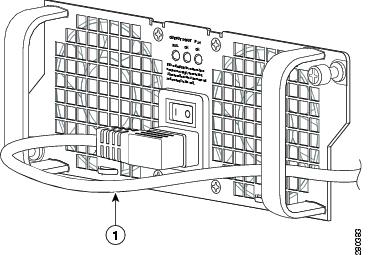
b.![]() Take the power cord and run it below the handles of the power supply in slot 1 (the power supply you are connecting) and the power supply in slot 0 (left) as shown in Figure 18. Make sure the power cord is hanging loosely so that it cannot be disconnected from the AC power inlet.
Take the power cord and run it below the handles of the power supply in slot 1 (the power supply you are connecting) and the power supply in slot 0 (left) as shown in Figure 18. Make sure the power cord is hanging loosely so that it cannot be disconnected from the AC power inlet.
Figure 18 Cisco ASR 1002-F Router AC Power Cord - Left and Right
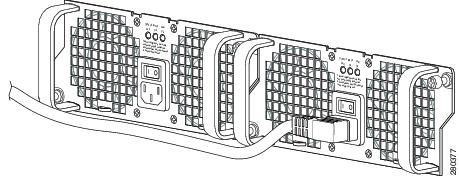

Figure 19 AC Power Supply Cord Cabling for the Cisco ASR 1002-F Router
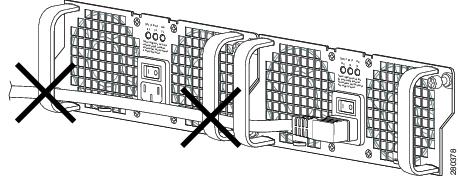

Note![]() Using a tie wrap for the AC power cable is optional and not necessary. However, if you do attach the AC power cable to a power supply tab and then you remove the AC power cable for some reason, check for any damage to the cable after you cut the tie wrap off. If the power cord is damaged, replace it immediately.
Using a tie wrap for the AC power cable is optional and not necessary. However, if you do attach the AC power cable to a power supply tab and then you remove the AC power cable for some reason, check for any damage to the cable after you cut the tie wrap off. If the power cord is damaged, replace it immediately.

Note![]() Turn the power supply switch to On (I) after both sides of the power cord are connected.
Turn the power supply switch to On (I) after both sides of the power cord are connected.
Step 6![]() Plug the AC power supply cable into the AC power source.
Plug the AC power supply cable into the AC power source.
Step 7![]() Place the AC power supply switch to the On (I) position.
Place the AC power supply switch to the On (I) position.
Step 8![]() The power supply LEDs light when power is supplied to the router.
The power supply LEDs light when power is supplied to the router.
This completes the procedure for connecting an AC power supply in the Cisco ASR 1002-F Router. You have completed a live change-out procedure (that is, removing and replacing an AC power supply) for an AC power supply not operating properly in the Cisco ASR 1002-F Router within five minutes.
Removing the DC Power Supply
Before you can remove a DC power supply from the Cisco ASR 1002-F Router, you must remove power from the power supply.

To remove the DC power supply from the Cisco ASR 1002-F Router, follow this procedure:
Step 1![]() Slip on the ESD-preventative wrist strap that was included in the accessory kit.
Slip on the ESD-preventative wrist strap that was included in the accessory kit.
Step 2![]() Place the power supply switch in the Standby position.
Place the power supply switch in the Standby position.
Step 3![]() Turn off the branch circuit breaker before touching terminal screws. Then start loosening terminal block screws to remove wires.
Turn off the branch circuit breaker before touching terminal screws. Then start loosening terminal block screws to remove wires.
Step 4![]() Remove the ground leads from the terminal block in this order.
Remove the ground leads from the terminal block in this order.
Step 5![]() Unscrew all of the power supply captive installation screws.
Unscrew all of the power supply captive installation screws.

Note![]() Four power supplies must be installed in the chassis at all times, with a minimum of two power supplies (one per zone) connected to the mains in order to power on the system and ensure sufficient cooling. The system fans are inside the power supply units and must spin for cooling. Because all the system fans can be powered by one power supply, the second power supply unit does not have to be powered on, but must be connected.
Four power supplies must be installed in the chassis at all times, with a minimum of two power supplies (one per zone) connected to the mains in order to power on the system and ensure sufficient cooling. The system fans are inside the power supply units and must spin for cooling. Because all the system fans can be powered by one power supply, the second power supply unit does not have to be powered on, but must be connected.

Step 6![]() Grasping the power supply handles, pull the power supply from the chassis.
Grasping the power supply handles, pull the power supply from the chassis.
Step 7![]() Replace the DC power supply within five minutes or the system will shutdown.
Replace the DC power supply within five minutes or the system will shutdown.
You have completed the procedure for removing a DC power supply from the Cisco ASR 1002-F Router.
Installing the DC Power Supply
This section provides information about replacing a DC power supply in the Cisco ASR 1002-F Router.

Note![]() The color coding of the DC-input power supply leads depends on the color coding of the DC power source at your site. Typically, green or green/yellow is used for ground. Make certain the lead color coding you choose for the DC-input power supply matches lead color coding used at the DC power source.
The color coding of the DC-input power supply leads depends on the color coding of the DC power source at your site. Typically, green or green/yellow is used for ground. Make certain the lead color coding you choose for the DC-input power supply matches lead color coding used at the DC power source.
Figure 20 Cisco ASR 1002-F Router Terminal Block


Warning![]() Never install an AC power module and a DC power module in the same chassis. Statement 1050
Never install an AC power module and a DC power module in the same chassis. Statement 1050

Warning![]() Installation of the equipment must comply with local and national electrical codes. Statement 1074
Installation of the equipment must comply with local and national electrical codes. Statement 1074
Step 1![]() At the rear of the router, check that the power supply Standby switch is in the Standby position.
At the rear of the router, check that the power supply Standby switch is in the Standby position.
Step 2![]() Ensure that the negative and positive leads are disconnected from the site power source and the circuit breaker is turned off.
Ensure that the negative and positive leads are disconnected from the site power source and the circuit breaker is turned off.
Step 3![]() Insert a DC power supply in power supply slot 0 or power supply slot 1 until it is full seated.
Insert a DC power supply in power supply slot 0 or power supply slot 1 until it is full seated.
Step 4![]() Using a wire stripper, strip approximately 0.55 inch (14 mm) from the negative, positive, and ground lead.
Using a wire stripper, strip approximately 0.55 inch (14 mm) from the negative, positive, and ground lead.
Figure 21 Cisco ASR 1002-F Router DC Power Supply

Step 5![]() Insert the stripped end of the ground lead all the way into the ground lead receptacle on the DC-input power supply, and tighten the receptacle screw using a 3.5 mm flat-blade screwdriver to a torque of 0.5 to 0.6Nm.
Insert the stripped end of the ground lead all the way into the ground lead receptacle on the DC-input power supply, and tighten the receptacle screw using a 3.5 mm flat-blade screwdriver to a torque of 0.5 to 0.6Nm.
Step 6![]() Insert the stripped end of the positive lead all the way into the positive lead receptacle and tighten the receptacle screw using the same 3.5 mm flat-blade screwdriver. Repeat this step for the negative lead.
Insert the stripped end of the positive lead all the way into the positive lead receptacle and tighten the receptacle screw using the same 3.5 mm flat-blade screwdriver. Repeat this step for the negative lead.

Note![]() Make sure the entire stripped end of each lead is inserted all the way into its receptacle. If any exposed wire at the stripped end of a lead is visible after inserting the lead into its receptacle, remove the lead from the receptacle, use the wire stripper to cut the stripped end of the lead, and repeat Step 4 through Step 6.
Make sure the entire stripped end of each lead is inserted all the way into its receptacle. If any exposed wire at the stripped end of a lead is visible after inserting the lead into its receptacle, remove the lead from the receptacle, use the wire stripper to cut the stripped end of the lead, and repeat Step 4 through Step 6.
Step 7![]() After tightening the receptacle screw for the ground, positive, and negative DC-input leads, use a cable tie to secure the three leads to the power supply faceplate.
After tightening the receptacle screw for the ground, positive, and negative DC-input leads, use a cable tie to secure the three leads to the power supply faceplate.

Note![]() When securing the ground, positive, and negative DC-input leads to the power supply faceplate, leave extra service loop in the ground lead to ensure that the ground lead is the last lead to disconnect from the power supply if a great deal of strain is placed on all three leads.
When securing the ground, positive, and negative DC-input leads to the power supply faceplate, leave extra service loop in the ground lead to ensure that the ground lead is the last lead to disconnect from the power supply if a great deal of strain is placed on all three leads.
Step 8![]() Turn the branch circuit breaker on at your site and the turn the Standby switch to the On (I) position.
Turn the branch circuit breaker on at your site and the turn the Standby switch to the On (I) position.
Step 9![]() Check that the power supply LEDs light when power is supplied to the router.
Check that the power supply LEDs light when power is supplied to the router.
You have completed the procedure for installing a DC power supply in the Cisco ASR 1002-F Router.
Contact Cisco
- Open a Support Case

- (Requires a Cisco Service Contract)
 Feedback
Feedback